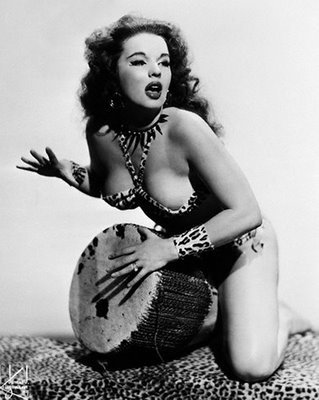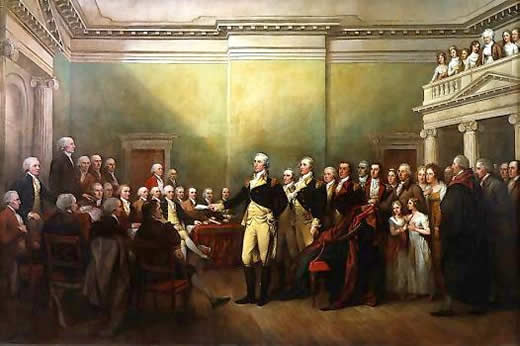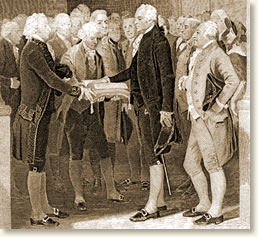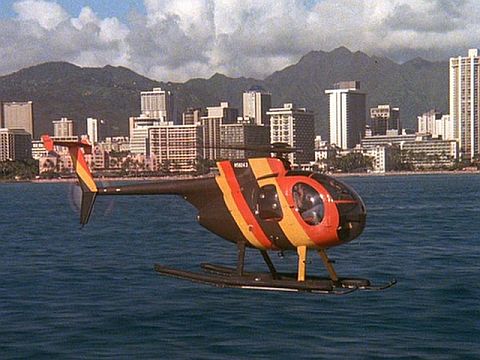I don't want to dig too much into the calendar reasons for Leap Day. My main interest is in finding out, since it is an oddball date on the calendar, what are some especially interesting or unusual that have happened on Leap Days in the past.

People generally associate frogs with Leap Day because of leap-frogging, but I choose the kangaroo.
(Photo from Elverado Junior High School)
The Numbers
- In short, the reason we have Leap Days is because the days need to get rounded off. The Earth takes 365.242199 days to orbit around the sun. Since our calendar doesn't allow for fractions of days, after a while those fractions build up, so we need to insert an extra day.
- If we didn't have Leap Day, after 100 years, our calendar would be out of sync with the planet's position relative to the sun by 24 days.
- It took a while before we got this figured out. Julius Caesar introduced the concept of Leap Year, but he had too many of them in his calendar. We didn't get that problem corrected until about 500 years ago.

Julius Caesar says, "I say, put Leap Day here!"
(Photo from somewhere on this bukisa page)
- All this is, of course, in the Gregorian calendar. Other calendars from around the world have Leap Years of their own too.
- If you don't have a calendar handy, here's how to figure out if year such & such was a Leap Year:
- If the year is evenly divisible by 4, it is a Leap Year except see #2.
- If the year is evenly divisible by 100, it is not a Leap Year, unless the number is also divisible by 400.
- Or you could just use this calculator.
The Lingo
- If you want to get really fancy when you talk about Leap Year, call it a bissextile year.
- The word doesn't mean anything other than Leap Year. It sounds like it has something to do with the number six because, originally, it did.
- The word comes from the Latin phrase bissextilis annis, which was the Roman way of referring to Leap Year. Except they counted their Leap Year differently than we do. Their Leap Day fell on February 24, and the phrase means "counting backwards to six days before the Calends of March."
- Or you could just remember that it means Leap Year.
- You could get fancy with the lingo another way and say that Leap Day is an example of an intercalary day.
- Intercalary means some sort of addition--a day, a month, an hour; any unit of time but usually a day--inserted into a calendar year.
- It also means, in botany, tissue growing between the upper and lower bracts on a plant stem.
- So if you were into grafting, you could graft an intercalary branch onto your favorite plants on the intercalary day of this year.

Except the only use I've seen of intercalary in the botanical sense is like this: a patch of cells that are different from those above and below, not a completely whole branch or stem.
(Image from TutorVista)
- Leap Year itself is a rather strange phrase. I wasn't able to find a definitive explanation for why we call it that, but it seems to be that, due to the addition of the extra day, the next day leaps ahead on the calendar. That is, if this were a non-Leap Year, the 1st would normally fall on Wednesday. But because we insert that extra day before it, the 1st leaps ahead to Thursday.
Notable Birthdays
Only about 0.07% of the world's population is born on Leap Days. Here are a few notable Leap Birthdays:
- 1736, birth of Ann Lee, founder of the Shaker religion.
- 1792, birth of Gioachino Rossini, Italian composer of such enduring hits as The Barber of Seville and William Tell.

Rossini. He's thinking, "Ho ho, I was born on Leap Day. And I write operas. Ho ho!"
(Image from Higher Revelations)
- 1904, birth of a man with 26 first names, each one starting with a different letter of the alphabet and in alphabetical order. Plus his last name was enormously long. His name: Adolph Blaine Charles David Earl Frederick Gerald Hubert Irvin John Kenneth Lloyd Martin Nero Oliver Paul Quincy Randolph Sherman Thomas Uncas Victor William Xerxes Yancy Zeus Wolfeschlegelsteinhausenberdorft Sr. That's actually the shortened version of his last name. At its full length, it weighs in at 585 letters (some sources say 590). He shortened it to Mr. Wolfe Plus 585 Sr.
- His profession? Typesetter.
- Also in 1904, Jimmy Dorsey, jazz saxophonist, composer, and conductor.
- 1916, birth of Dinah Shore, actress, singer, talk show host.
- For all you literary types, in 1920, Howard Nemerov was born.
- Also in 1920, birth of James Mitchell who played Palmer Cortlandt for decades on All My Children.
- 1928, birth of Annie Blanche Banks, except she became a star of the burlesque stage and changed her name to Tempest Storm.

Whew. A lot of photos of Tempest Storm are NSFW. This is a rather tame one (get it? Tame, in spite of the jungle print?) and it's got a bongo drum in it. She's being musical.
(Photo from Holly Graphics)
- 1940, birth of Seattle Slew's trainer, Billy Turner.
- In 1940, Peter Anthony Keogh, the first of three generations born on Leap Day. His son Peter Eric Keogh was born on Leap Day in 1964. Peter Eric's daughter & Peter Anthony's granddaughter, Bethany Wealth Keogh, was born Feb 29, 1996.
- 1944, birth of Dennis Farina, actor, most recently on Law & Order.

Dennis Farina says, "Hey. Don't try to tell me I can't celebrate my birthday each year just because I was born on the 29th."
(Photo from Hollywood Memorabilia)
- In 1948, twins Yuri and Nikolai Pimenov were born. They went on to win the silver medal in the 1976 Olympics for coxless (that means no one is in the boat yelling at them) pair rowing.
- 1960, birth of Heidi Henriksen. She was the first of 3 siblings born on consecutive Leap days. In 1964, her brother Olav was born on February 29. In 1968, youngest brother Leif-Martin was born on February 29.
- Lots of hockey players: Lyndon Byers (1964), Simon Gagne (1980), Cam Ward (1984), and Adam Sinclair (1984).
- And football players too: John Niland, Cowboys (1944); Gary Conklin, 49ers (1968); Bryce Paup, Packers and Bills (1968); Fabien Bownes, Bears (1972); Mark Farraway, CFL's Eskimos (1972).

If you get to celebrate the actual anniversary of your birth only every four years, your cake had better be something special like this. This is a vanilla hazelnut cake that one friend made for Katie, who was celebrating her 7th Leap-Year-Day. That thing on the frog's tongue that looks like a bandage is actually a fly.
(Photo and cake by saptally on Cake Central)
Misogynistic Traditions That I Hope Have Died Completely
- In 1960, the first Playboy club opened. Hef chose to open his club on Leap Day, because it is traditionally known as Bachelor's Day.
- But this doesn't quite make sense because Bachelor's Day is traditionally when women, who are culturally "not allowed" to propose marriage to men, are on this oddball day allowed to propose marriage and the man is supposed to accept. The bachelor may refuse, but only if he pays a penalty. The penalty varies depending on the country, but in many European countries it was 12 pairs of gloves, so that she will have one pair for each month and will thus be able to hide the fact that she is not wearing a wedding ring.
- This tradition goes all the way back to Irish lore when St. Bridget supposedly asked St. Patrick if there could be one day out of the year when women could propose marriage. He agreed, but said it had to be on February 29th.
- Similarly, this day is also sometimes known as Sadie Hawkins' Day, after a character in the cartoon strip Li'l Abner--that cultural bastion of civility. Sadie, renowned for her ugliness, was an inveterate man-chaser. Out of pity or some other equally distasteful response, it was agreed that on February 29, whatever man she was chasing at the time would have to accept her proposal.
- Let's move on.
Actual Historical Events
Some fairly major events took place in African American history on Leap Day. True, February is Black History Month, but it's pretty remarkable that three of the events which are the reason that month was so designated happened on a Leap Day.
- 1968, the Kerner Commission Report was released, which said that the recent riots that had been taking place all across the country were due to "white racism." This may seem patently obvious to us now, but at the time, some people were saying that the riots were fomented by African American political groups in a nationwide conspiracy. The report said that "our nation is moving toward two societies, one black, one white--separate and unequal." It said that major remedies should be undertaken at once, otherwise American society would face continued polarization "and, ultimately, the destruction of basic democratic values."
- In 1972, Hank Aaron signed a contract with the Atlanta Braves for $200K, which made him the highest-paid baseball player at the time. When I first read this, I thought, big deal. But then I remembered, hey, he was African American. That really was a big deal.

Also in 1972, Hank Aaron hit his 649th home run, moving him past Willie Mays on the list of most home runs. He wound up breaking Babe Ruth's record with 755 total in his career, and he still holds the record for the most RBIs: 2,297.
(Photo from This Day in Georgia History)
- 1940, Gone with the Wind was awarded eight Oscars for Best Picture, Director, Screenplay, Cinematography, Art Direction, Film Editing, and Actress. Most exceptionally, Hattie McDaniel was awarded the Oscar for Best Supporting Actress for her portrayal of Mammie. She was the first African American actor ever to win an Oscar.
Here she is accepting her Oscar. I thought you might like to hear her talk without the thick accent she adopted in the movie.
Enjoy your Leap Day to the fullest!
Sources
Collins English Dictionary, bissextile, intercalary
Nancy C. Wooten, Leap Year Round-Up, Orangeburg Times & Democrat
Honor Society of Leap Day Babies, Famous Leapers
ClassicalNet, Gioachino Rossini
Museum of Hoaxes, World's Longest Surname
TheyNow.com, 29th Leap Day
History.com, This Day in History: February 29
Bleacher Report, The 50 Greatest Baseball Players of All Time, December 17, 2009






































